


|
Commenced:
|
01/07/2012 |
|---|---|
|
Submitted:
|
09/08/2012 |
|
Last updated:
|
15/01/2018 |
|
Location:
|
Chão Sobral, Aldeia das Dez - OHP - Coimbra, PT |
|
Climate zone:
|
Warm Temperate |
(projects i'm involved in)
Back to Mountain Steep Permaculture - Permacultura em Declive de Montanha
Project: Mountain Steep Permaculture - Permacultura em Declive de Montanha
Posted by João Gonçalves over 12 years ago
Elements and functions of soil generation in warm temperate mountain rocky slopes. (post under construction)
NOTE - This proccess was developed more than 100 years ago by people that used very little money, almost no money at all, and did not use modern age fossil fuels. It was intended to yield staple foods (mostly corn, potatoe, beans) with a surplus needed to create a age old means of exchange - grain. Probably it was worth the time they had available and given their ecosystem conditions.
In is only better understood by understanding and researching its ecological, historical and cultural context. Population growth also plays a role in this cause-consequence loop.
This soil generation strategy involves the following elements-functions to be managed.
- Soil micro-organisms
Bacteria and fungae, and the many others!
Functions - yields - outputs:
- eat - decompose - organic material - biomass of dead micro-organisms, plants and animals
- the soil food web trophic cycling - breeding, growing and dying - creates a diversity of biologically available minerals that plants feed on, out of chemically availabe materials
- store minerals and water in their bodies-biomass
(Search youtube for Dr. Elaine Ingham...)
Inputs:
- water (cold/wet season rain and dry/warm season flood irrigation)
- are fed by and grow their numbers thanks to the carbon rich Animal deep litter bedding / manure buryied in the Soil by Humans.
- Plants
Both mountain wild plants and plants grown as crops by humans, annuals and perennials, etc. (a list soon)
Functions - yields - outputs:
- are solar pannels turning solar energy into plant biomass, photosynthesis, the basis of the living organisms food chain
- capture CO2 and release of Oxigen
- feeding soil micro-organisms as dead bodies or through their root exudates
- animal (goats, sheep, rabbits, chickens, ducks, humans) foods as leaves, fruits, stalks, branches, seeds, bark.
- Animal bedding. Mountain wild perennial plants are coppiced or pruned only once a year and added to the animal bedding.
- green manure, added fresh directly when burying the animal bedding or as a substitute for this.
- mulch, is always used to slow and spread water when doing sheet flood irrigation
Inputs:
- sun light
- water
- air
- biologically available minerals around their root systems
- disturbance - pruning, coppice, by animals or humans
- management according to season - seeding, harvesting, irrigation

Pic. 1 - 2004 - Chao Sobral street - Function: Harvesting and transporting wild mountain plants to the animal bedding.
Plants that were harvested by coppice or pruning (Erica, Cytisus, Cistus and Genista spp.) and bundled using a sisal rope are carried on the back by humans to be used as animal bedding and fodder, or has green manure and mulch. Today gas trimmers are also used to cut these plants and tractors are used to move several bundles in one trip.
- Farm animals
Goats, sheep, rabbits, chickens, ducks.
Functions - yields - outputs:
- Chewing the plants outputs, they are precious bio-digestors in this rather brittle ecology (altered by millenia of human actions) - the uneven distribution of humidity throughout the year. 6 months cool/cold/wet winter generates a peak of green biomass in late Spring/early Summer that is not decomposed during the following dry warm season and becomes a potencial fuel for flames - fire hazard ... animals help turn this fire fuel biomass into rich biologically activated dead plant material.
- Trample the dead plant bedding inside the pen (thin branches and leaves of shrubs, straw, stalks, etc). In this, as they are penned in stacked dry stone wall houses (pic. below), they add their dung and urine to the vegetable bedding, developing about 1 to 1,5 mts deep litter.
- Meat, milk, eggs, wool, dead body parts for dogs, cats and wild animals/foxes
Inputs for goats and sheep:
- Managed by humans:
+ Everyday, fresh plants for new bedding
+ Everyday, outside the pen for 2-3 hours, managed rotational grazing on grass or mountain forage
+ Everyday, in the pen, straw or hay
+ At least once a year, breeding season,
- Al year around - shelter, warmth in the cold season, cool in the warm season - the traditional pens, shelters ground floor are carved in the bed rock and built against the slope, have thermal mass about 50 cm thick stacked dry stone walls around. The deep bedding being trampled generates some heat warms up the air is stored in the stone thermal mass around.
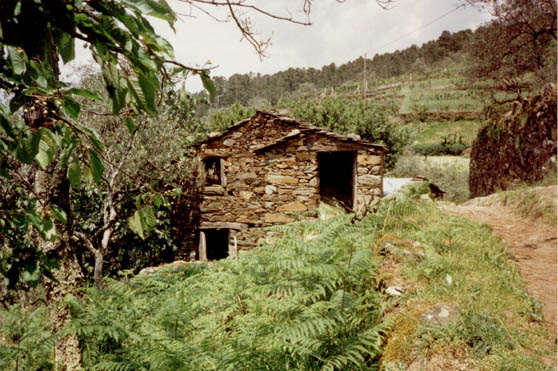
Pic. 2 - Stacked dry stone wall two floors goat shed (fig tree that "yields dried figs" standing on the left of this building). Function 1 - Ground floor is the shelter - animal pen, function 2 - deep litter bedding storage, function 2 - upstairs roofed by chestnut poles and slate or clay tiles - Pic. 3 - is the year around animal fodder storage, and hay, corn stalks, dry bean pods, winter dry fodder storage.
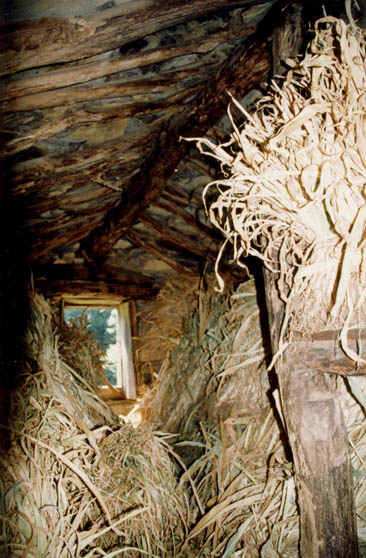
Pic. 3 - Function - Storage - Annualy grown and dried sheep and goat winter fodder (corn, straw, hay).

Pic. 4 - Goat being milked. Goats and rabbits are kept in the same shed. Fresh biomass is added everyday to their deep litter bedding.
- Humans
Humans (used to ) work as whole families, grand parents, parents and children have different functions and one purpose: keep and improve their existing self-and hamlet - reliant system.
Functions - yields - outputs:
- People function as their life and daily cycle managers, designers
- Gardeners and forest managers
- Builders of animal shelters
- Almost daily, to harvest with hand sharp blade cutting tools plants for animal bedding and as "tractors" to transport this material on their back walking down narrow rocky mountain trails
- To handle and move animals - daily rotational grazing
- To move biomass, bundles on their backs to the crop field
- By the end of the cold/wet season, teams of 3 to 8 people (usally men and 3 generations) open trenches and bury the animal bedding to prepare the soil to be planted with warm season crops.

Pic. 5 - Sheeps and goats together, grazing rye that was planted in the beginning of the wet and cold season. Corn was harvested from this field in the end of the dry and warm season - corn stalks stem base still visible in between the grass.
This grazing takes place mostly in the morning time and lasts for 2 to 3 hours only, after that the animals are moved back to their pen, and keep on enriching or biodynamically activating the deep litter bedding.
As soon as 6 to 7 year old, farm or hamlet children were able to do the goat or sheep shepperd function that takes 2 to 3 hours per day. I got used to ... At the same time, out in the field or mountain i used to play with other shepperds and build a fantasy world mimicking the life structures around in the village.
- Animal bedding
The function of this organic material, composed of animal urine and faeces plus dead plants bodies that were coppiced or pruned, trees, vines, shrubs, grasses, legumes, herbs, is two feed the soil.
It is likely that there is more than 30 different species of plants in this material (most of them wild and "weeds"). One layer of freshly cut plant biomass is added everyday and covers completely the layer added the day before plus recent animal waste.
Once the deep litter animal bedding reaches about 1 to 1,5 metre deep, humans use manual tools to take it out from the animal pen and move it to the growing area (a Zone 1, 2 or 3), using their back, or some mechanic tractor system.
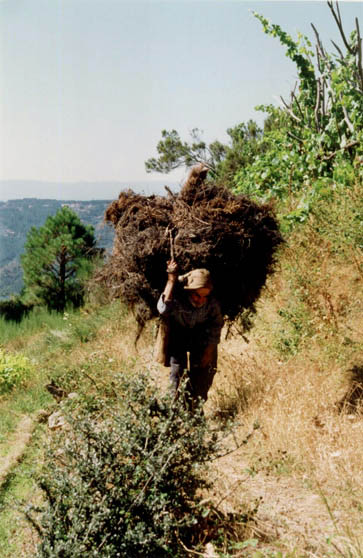
Pic. 6 - People as tractors and trailers, moving sheep deep litter bedding from the pen - animal shed, to the growing area - Zone 2, where irrigated corn field will be planted.
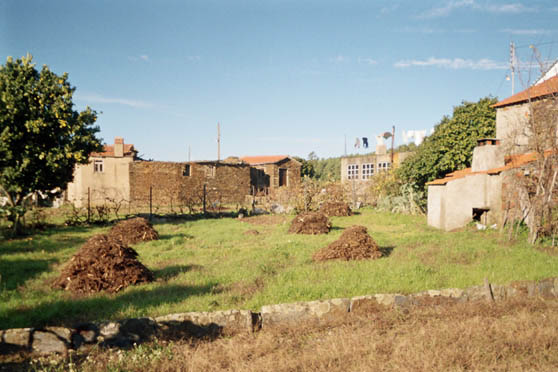
Pic. 7 - Zone 2-3 - Summer grows corn - Winter grows pasture - Thick heap of animal carbon rich deep litter sits and rests in the open field, under the summer sun and the winter rain. There it waits, in the growing area that is now pasture, for weeks or months, until the edge period between the wet/cold season and the dry/warm season. By then it will be buried and thus feed the soil food web and re-activate the sponge effect.
- Soil
Is the bed or medium where "underground composting" takes place. This takes place in 1 year cycle, while on the surface 2 annual crop growth cycles take place, one through the dry/warm season and another through the wet/cold season.
Agriculture soil area is contained and is supported by terraces. These were built through the last 5-7 centuries.
Properties areas are very small, they have been divided by the family members, and given the population growth of the last 700 years ... Plot sizes varies from a dozen of square meters to some hundreds of square meters. Depth of fertile soil varies inside the same plot: near the retaining wall is deeper and near the next upper retainning wall is shallower, 10 to 20 cms, below which lies xist bed rock used to make build terrace walls.
Hand tools or small tractors are used to revolve the fertile soil and bury the animal bedding and green manures.
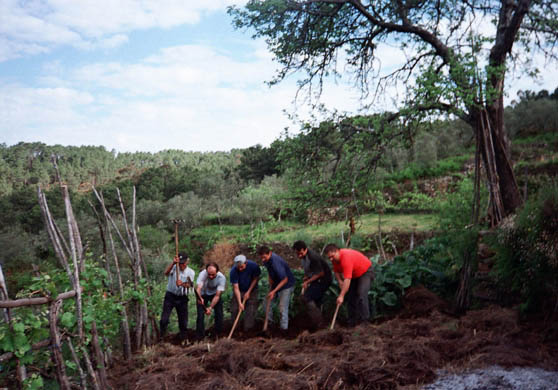
Pic. 8 - The team of humans (relatives and friends) uses manual tools to open trenches and bury the litter from the animal bedding, the brown scattered stuff of the floo.
The tilling done by hand is a specific "handmade-slow-passive" strategy to (1) compost/process big amounts of biomass - animal bedding, and at the same time (2) get the soil aerated, (3) through "disturbance", aeration and nitrogen rich animal and green manures, selecting for bacteria dominance, trigger burst of soilfoodweb microbial activity during late Wet but warmer season, (4) to compost on site/get rid of weeds and previous crop litter residue, (5) getting the soild ready for planting or seeding the nitrogen and water thirsty anual basic crops-foods like maize, potatoes, palm-cabbage, legumes. And also tomatoes, peppers, pumpkins, spinach, ...

Pic. 9
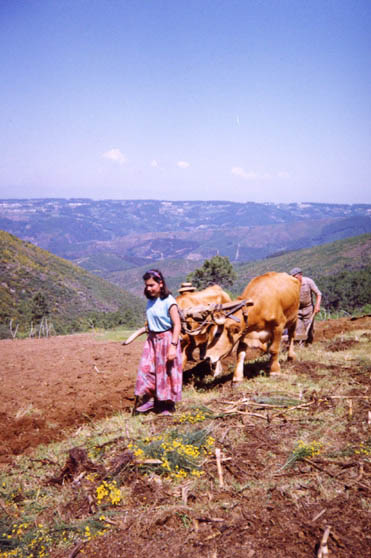
Pic. 9 and 10 - West facing slope - Spring 1990 - Team of humans with different functions - leading the ox, controlling the plow, using a manual tool to move animal bedding and green manure with yellow flowers (Cytisus spp.) into the trench. Preparing the soil for sowing corn and beans.

Pic. 11 - Soil sponge is ready. The surface soil, resulting from last year tillage, is aerated and weed free to receice seeds and seedlings. The soil underneath is composed of new foods for the soil food web and is like a sponge ready to receive flood irrigation and hold water. Potatoes are being densely sowed in these trenches. After a few weeks this plot will be mulched with maritime pine needles and receive the careful first flood irrigation. A spine and rib, or dendritic pattern is used to design the water channels in this potatoe sloped field, standing over a "creek tunnel" - see post http://www.permacultureglobal.org/posts/3379.
After the frost free dry season potatoe crop, turnips and brassicas will follow in wet cold season with raking depth - surface tillage only.
- Mulching
Strategy and techniques ...
- Summer Flood Irrigation and "Spine and Ribs" Water Path Pattern
Functions to irrigate, once every week or more, deeply and fast, the sun and warmth loving fast growing crops rooting fast through the spongy soil (corn, beans, pumkin, potatoe).
To minimise water evaporation from the soil 2 strategies are used:
- very dense planting (specially potatoes), no walking paths, even water ways become shaded
- mulch (deep litter animal bedding is used for corn, maritime pine needles are used for potatoes)
The dry/warm season irrigation cycle functions from June until September. The water comes by gravity down the plastic pipe from mountain community owned and shared springs way up at 800 to 900 mts high to concrete tanks at about 700 mts high. In this location, Commons Land, privately owned tanks were built by each family. And 2 community owned tanks were also built.
In these tanks, filled once every week or every 8 days or 9 days ... , each family or owner stores water and uses it when it is most needed by the crops.
This spring water sharing is rotational, cyclical (each spring has its rythm and set of owners) and the amount of water / time each family has depends on the amount of irrigated surface area he or she owns.
Each minute or hour of water/time is linked to a specific crop field. This was a pattern started by our ancestors and kept from generation to generation.
Permaculture principles at work:
- Everything has advantages and disadvantages
> minus / this proccess requires a "lot" of time-labor-energy in moving around plant biomass and animals
> plus / it becomes a social help-eachother-party proccess, people build muscle and aerate their lungs and blood - have daily exercise while doing it.
- Use of biological resources - it is 100% local and organic.
- Relative location - All elements of the proccess have outputs and inputs that fit to the other elements needs, yields and functions.
- Energy efficiency planning - in general it takes advantage of slope and gravity, animal pens are near the source of the biomass and near the growing field that receives the deep litter.
- Close loop energy cycling - there is no waste, everything becomes soil and enriches the system.
- Optimal use of edge - biomass is sourced from edge areas in between the crop field and the forest. In the terraces solar exposure is maximised to favour annual staple crops.
- Increase biodiversity - different animals and plant species have a crucial role.
- Ecological succession and use of patchy disturbance regimes - animal rotational grazing is used in the crop area during the wet/cold season, severe prunning and coppice of wild plants, annual soil socializing tilling disturbance is a aerobic massage.
- Each element has multiple functions - Even terrace retaining walls - thermal mass warmed by the sun - function to create a warmer microclimate for growing wild herbs and grape vines on top of them.
- For each important function we have many elements - for biomass sources we have multiple plants, and for biological activators we have different animals. For the manual labor people help each other, many hands make light work ...
- Work where it counts - each stage of the proccess happens when the moment is right in the wet to dry season spectrum. Careful attention to the moon cycles, seeding timing before and after the Dry season, moisture in the soil, animal management and rotational grazing. Each crops fits to the wet to dry season conditions spectrum.
- Small scale intensive - this is all about it. It takes daily small inputs, everyday, slow and steady forward. It works best with small groups 3 to 5 people that can share and rotate tasks - biomass harvest, animal management, moving and burying animal bedding..
You must be logged in to comment.




Note: The various badges displayed in people profiles are largely honesty-based self-proclamations by the individuals themselves. There are reporting functions users can use if they know of blatant misrepresentation (for both people and projects). Legitimacy, competency and reputation for all people and projects can be evidenced and/or developed through their providing regular updates on permaculture work they’re involved in, before/after photographs, etc. A spirit of objective nurturing of both people and projects through knowledge/encouragement/inspiration/resource sharing is the aim of the Worldwide Permaculture Network.
 |
MemberA member is a permaculturist who has never taken a PDC course. These cannot become PDC teachers. Members may be novice or highly experienced permaculturists or anywhere in between. Watch their updates for evaluation. |
|---|---|
  |
Permaculture MatchmakerOne of these badges will show if you select your gender and the "I'm single, looking for a permaculture partner" option in your profile. |
 |
PDCPeople who claim to have taken a Permaculture Design Certificate (PDC) course somewhere in the world. |
 |
PDC VerifiedPeople who have entered an email address for the teacher of their PDC course, and have had their PDC status verified by that teacher. Watch their updates for evaluation. |
 |
PRI PDCPeople who’ve taken a Permaculture Research Institute PDC somewhere in the world. |
 |
PDC TeacherPeople who claim to teach some version of PDC somewhere in the world. |
 |
PRI TeacherWith the exception of the ‘Member’ who has never taken a PDC, all of the above can apply to become a PRI PDC Teacher. PRI PDC Teachers are those who the PRI recognise, through a vetting board, as determined and competent to teach the full 72-hour course as developed by Permaculture founder Bill Mollison – covering all the topics of The Designers’ Manual as well as possible (i.e. not cherry picking only aspects the teacher feels most interested or competent in). Such teachers also commit to focussing on the design science, and not including subjective spiritual/metaphysical elements. The reason these items are not included in the PDC curriculum is because they are “belief” based. Permaculture Design education concerns itself with teaching good design based on strategies and techniques which are scientifically provable. PRI PDC Teachers may be given teaching and/or consultancy offerings as they become available as the network grows. |
 |
Aid WorkerThe individual with this badge is indicating they are, have, or would like to be involved in permaculture aid work. As such, the individual may or may not have permaculture aid worker experience. Watch their updates for evaluation. |
 |
ConsultantThe individual with this badge is indicating they are, have, or would like to do paid permaculture design consultancy work. As such, the individual may or may not have permaculture consultancy experience. Watch their updates for evaluation. |
 |
Community ProjectCommunity projects are projects that help develop sustainable community interaction and increase localised resiliency. |